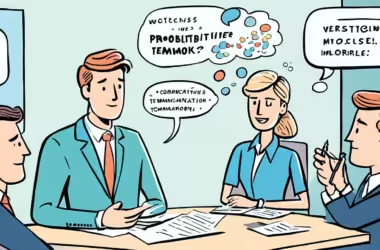Have you ever wondered about Apple’s secret to staying ahead? It’s their PIP culture. This strategy boosts performance and accountability. It matches Apple’s goals for top-notch quality. It also boosts employee commitment and their work output.
Looking closer at Apple’s PIP culture shows its impact. It makes the workplace better in the tech world. This approach helps staff grow constantly. By understanding PIP culture, we see how Apple faces challenges, adapts, and wins against rivals.
Understanding PIP Culture at Apple
At Apple, the PIP culture is about spotting areas where employees can do better. It’s a system that helps people grow by giving them specific feedback and support. This ensures everyone is working towards the company’s main goals. Performance improvement plans are key for keeping everyone accountable and open to feedback.
Definition of PIP Culture
PIP culture at Apple means managing performance in a way that boosts improvement. It’s all about giving positive guidance so everyone has a chance to get better and grow their skills. Through this process, problems with performance are tackled head-on. This makes the workplace better and more effective.
The Role of Performance Improvement Plans
In Apple’s PIP culture, performance improvement plans are crucial. These plans set clear goals and provide coaching to help employees improve. They help workers meet their full potential and fit into Apple’s big picture of success. But it’s not all about fixing issues. It’s mostly about personal growth and achieving more in the long run.
The Importance of Strategic Leadership
In today’s fast-changing business world, strategic leadership is more important than ever. Organizations must adjust quickly to new situations. Leaders need to think about the future as well as today’s challenges. This type of leadership is not just managing. It’s about being innovative, adaptable, and predicting market trends.
What is Strategic Leadership?
Strategic leadership is about guiding the organization in a clear direction. It involves tackling complex issues and crafting a vision that fits with the company’s goals. This goes beyond just looking at the short-term. Strategic leaders focus on the long-term landscape and push for growth by making smart choices and planning ahead.
Key Traits of Strategic Leaders
Effective strategic leaders have key qualities:
- Visionary Thinking: They can imagine a bright future for the organization.
- Decisiveness: They can quickly decide on a course of action.
- Strong Analytical Skills: They understand data well and make wise decisions.
- Encouragement of Innovation: They are ready to challenge the usual and encourage new ideas.
- Emotional Intelligence: This important quality helps them manage and understand team dynamics.
How PIP Culture Drives Innovation
Apple’s PIP culture is key to its innovation. It highlights the value of doing better and welcoming constant feedback. Workers feel free to try new things. This fits with Apple’s goal to create pioneering products.
Encouraging Continuous Improvement
Apple uses Performance Improvement Plans to boost improvement. It sets clear goals, making employees more into self-review. This makes more employees work on new projects. It also builds a culture of taking charge, aiding in growth.
The focus on continuous improvement in PIP means all aim to do better. They try to excel in their tasks.
Fostering a Culture of Experimentation
Apple’s PIP culture welcomes trying new things. It lets employees risk wisely, important for new ideas. This results in many patents each year. It shows how PIP leads to tech progress.
This urge to try new ways leads to launching new products. It raises Apple’s position in the market. And it helps with the company’s yearly income increase.
The Influence of Workplace Culture on Performance
Workplace culture is key in how well employees do and feel at work. A good work atmosphere encourages team work, creativity, and talking openly. These are crucial for top-notch performance. Companies like Apple know that a strong culture keeps employees happy, staying longer, and working better. Working on the culture helps everyone work better together.
Creating a Positive Work Environment
To make a work place positive, you need to:
- Encourage everyone to speak freely and be clear with each other.
- Give tools for learning new skills and growing personally.
- Celebrate what employees do well.
- Let people offer feedback to help improve things.
These steps not only make the work culture better but also boost how well employees do their jobs. Studies show that happier workplaces have happier employees. For example, 87% of workers at Apple say their current culture hurts how they feel at work.
The Connection Between Culture and Employee Satisfaction
How workers feel at work is closely linked to the culture there. A welcoming culture means people are more involved and less likely to leave. But, 65% of Apple workers say their current culture makes working together hard. This is an issue that needs fixing. Also, 84% think a more supportive culture would make everyone more productive.
For the best results from all teams, companies need to focus on making the culture better. They should create ways to report issues safely and resolve them in a supportive manner. This cuts down bad behavior, makes work life better, and workers more satisfied.
Leadership Styles that Complement PIP Culture
Leadership styles are vital for Apple’s PIP culture success. Visionary and participative styles help make an innovative environment. They are key to improving performance.
Visionary Leadership
Visionary leaders set clear goals. They inspire their teams with a shared vision. This style encourages creative thinking and challenging the usual ways.
It matches PIP culture’s focus on continuous improvement. Visionary leaders help Apple explore new ideas. This fosters a culture of innovation among the workforce.
Participative Leadership
Participative leadership lets team members make decisions together. It creates a feeling of ownership and teamwork. Employees offer their ideas, boosting engagement.
This approach respects everyone’s input. It fits PIP culture’s core principles well. Participative leadership increases employee happiness and their work performance.
Anticipating Challenges and Driving Change
Strategic leadership is key in today’s fast business world. It helps leaders make early decisions to tackle market changes. They need to have strong strategies to stay strong and ahead.
Proactive Decision Making in Leadership
Being proactive is crucial for leaders today. They must look ahead and act quickly. Leaders should always be learning and improving their skills. This creates a culture ready for innovation.
They should work together well, be flexible, and ready to change. This helps them make decisions quickly that help the company in the long run.
Adapting to Market Dynamics
Being able to adapt is very important in today’s market. Leaders must spot trends and shake things up. Companies that keep learning and innovating can face tough times better.
Organizations should offer a variety of products and services. This makes them less at risk and helps them grow, even when things change.
Employee Engagement and Motivation
Employee engagement and motivation are key to success in any organization. Building trust and good communication lays this foundation. In Apple’s PIP culture, leaders balance accountability with support. This helps employees do well and stay loyal. Aligning with business goals is made easier.
Building Trust and Communication
Trust is essential in teamwork. Open and clear communication helps employees share ideas freely. Studies show connected and supported workers are more engaged. Creating a welcoming environment for feedback boosts motivation and performance.
Balancing Accountability with Support
Keeping accountability and support in balance is crucial. Leaders must set clear goals and give the tools needed for success. This approach helps employees see their contributions, feeling responsible and valued. Supported employees stay engaged and push towards team success.
Transformative Effects of PIP Culture
PIP culture has changed many tech companies dealing with big challenges. For example, LinkedIn’s engineering teams saw a huge shift when they started using performance improvement plans. This move aimed to fix their dropping revenue growth.
Revenue had fallen from 34% in 2022 to just 10% in 2023. So, nearly 10% of their engineering team got PIPs. This showed their commitment to always getting better.
Case Studies of Successful Turnarounds
LinkedIn is a great example of how PIP culture can turn things around. As the company adapted to new market trends, their engineering managers and support staff saw stricter performance reviews. They got more lower ratings than before.
This was tough, but it made employees more engaged. It focused on personal responsibility and having clear plans for growth. Employees were pushed to think about growth, which helped the company stay innovative.
Lessons from PIP Culture Implementation
Learning from PIP culture shows important lessons for companies. Continuous feedback is key for better performance and teamwork. At companies like Apple, the attitude of employees and their interpersonal skills are really important.
They help create a unique experience for customers. With programs focused on knowledge and sensible decision-making, companies can create a competitive but healthy environment. This leads to more productivity and innovation.
Potential Criticisms of PIP Culture
The use of performance improvement plans (PIPs) at Apple has brought mixed reactions. Some criticisms of PIP culture come from misunderstandings. While they seem like they cause stress, PIPs really aim to help employees grow.
Common Misconceptions
Some think PIPs are just for disciplining rather than helping. But actually, PIPs help spot and fix skills gaps. They help employees get better by setting clear goals over 30, 60, or 90 days. Surveys show 65% of workers want more feedback, showing the value of good communication in PIPs.
Addressing Employee Concerns
Many worry about the effects of being on a PIP. Explaining that PIPs are meant to help, not hurt, can ease these worries. With open talks and regular updates, employees feel heard. A good PIP can keep and make employees more committed, turning critiques into chances for growth.
The Future of PIP Culture at Apple
At Apple, the future of PIP culture is key to growth and innovation. The company is adapting to new expectations and demands. This change is vital to stay ahead in the market. Strategic leadership development is changing how performance management works at Apple.
Trends in Leadership Development
Leadership at Apple is changing. New ways of working mean new leadership styles. Apple plans to use inclusive and collaborative methods.
Leaders will now coach and mentor, moving away from old-school styles. This shift focuses on emotional intelligence and being adaptable. These skills are important for working with diverse teams.
Innovations to Anticipate
Apple is always looking to innovate, especially with performance plans. Technologies like artificial intelligence and big data are changing how we track performance. These changes make way for continuous learning and better employee engagement.
Flexible work options are also becoming more common. Companies like Salesforce and Twitter show how adaptable work policies support employee well-being.
Conclusion
PIP culture at Apple plays a big part in sparking innovation and growth. It focuses on accountability, constant improvement, and smart leadership. This approach improves how employees perform. It also keeps Apple ahead in the technology world.
About 65% of employees want more feedback. A well-done Performance Improvement Plan (PIP) can really help unlock their potential. Actionable feedback is key in this process.
The PIP culture at Apple tackles performance issues, creating a supportive environment. This helps employees do their best. Almost 25% of workers have thought about quitting due to not enough feedback. Apple’s careful feedback helps keep important talent.
This system also helps develop skilled workers with plans made just for them. Apple sets clear goals for 30, 60, and 90 days. This shows how dedicated they are to helping their employees grow. It links strong leadership to more innovation.
In the end, PIP culture is crucial for success and empowering workers. It fosters a culture of growth and chance. Apple not only keeps its lead in the market but also pushes the whole tech world forward.






